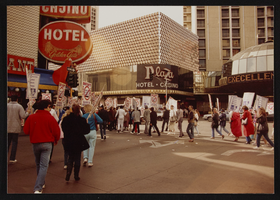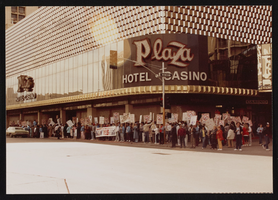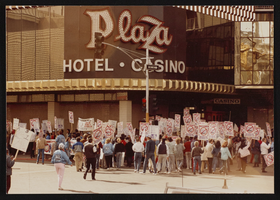Search the Special Collections and Archives Portal
Search Results

Coalition Labor Union Women (CLUW) rally, Culinary Union, Las Vegas (Nev.), 1990s (folder 1 of 3), image 3
Date
1990 to 1999
Description
Arrangement note: Series I. Demonstrations, Subseries I.B. Other Demonstrations and Strikes
Image

Coalition Labor Union Women (CLUW) rally, Culinary Union, Las Vegas (Nev.), 1990s (folder 1 of 3), image 4
Date
1990 to 1999
Description
Arrangement note: Series I. Demonstrations, Subseries I.B. Other Demonstrations and Strikes
Image

Coalition Labor Union Women (CLUW) rally, Culinary Union, Las Vegas (Nev.), 1990s (folder 1 of 3), image 5
Date
1990 to 1999
Description
Arrangement note: Series I. Demonstrations, Subseries I.B. Other Demonstrations and Strikes
Image

Coalition Labor Union Women (CLUW) rally, Culinary Union, Las Vegas (Nev.), 1990s (folder 1 of 3), image 6
Date
1990 to 1999
Description
Arrangement note: Series I. Demonstrations, Subseries I.B. Other Demonstrations and Strikes
Image

Coalition Labor Union Women (CLUW) rally, Culinary Union, Las Vegas (Nev.), 1990s (folder 1 of 3), image 7
Date
1990 to 1999
Description
Arrangement note: Series I. Demonstrations, Subseries I.B. Other Demonstrations and Strikes
Image

Coalition Labor Union Women (CLUW) rally, Culinary Union, Las Vegas (Nev.), 1990s (folder 1 of 3), image 8
Date
1990 to 1999
Description
Arrangement note: Series I. Demonstrations, Subseries I.B. Other Demonstrations and Strikes
Image

Coalition Labor Union Women (CLUW) rally, Culinary Union, Las Vegas (Nev.), 1990s (folder 1 of 3), image 9
Date
1990 to 1999
Description
Arrangement note: Series I. Demonstrations, Subseries I.B. Other Demonstrations and Strikes
Image

Coalition Labor Union Women (CLUW) rally, Culinary Union, Las Vegas (Nev.), 1990s (folder 1 of 3), image 10
Date
1990 to 1999
Description
Arrangement note: Series I. Demonstrations, Subseries I.B. Other Demonstrations and Strikes
Image

Coalition Labor Union Women (CLUW) rally, Culinary Union, Las Vegas (Nev.), 1990s (folder 1 of 3), image 11
Date
1990 to 1999
Description
Arrangement note: Series I. Demonstrations, Subseries I.B. Other Demonstrations and Strikes
Image

Coalition Labor Union Women (CLUW) rally, Culinary Union, Las Vegas (Nev.), 1990s (folder 1 of 3), image 12
Date
1990 to 1999
Description
Arrangement note: Series I. Demonstrations, Subseries I.B. Other Demonstrations and Strikes
Image
Pagination
Refine my results
Content Type
Creator or Contributor
Subject
Archival Collection
Digital Project
Resource Type
Year
Material Type
Place
Language
Records Classification
